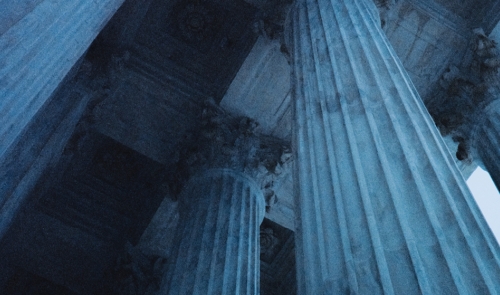The Court’s contribution
Rachel Barkow examines the Supreme Court’s role in the rise of mass incarceration

The sobering statistics are familiar by now. While the United States contains less than 5 percent of the global population, it incarcerates nearly a quarter of the world’s prisoners. With almost two million people behind bars, the US has an incarceration rate five to ten times that of other industrialized countries. Forty-five percent of Americans have experienced the incarceration of an immediate family member.
Critics of the US criminal justice system have often pointed to the “tough on crime” politics originating during the Nixon administration as a primary culprit leading to mass incarceration today. But in her new book Justice Abandoned: How the Supreme Court Ignored the Constitution and Enabled Mass Incarceration (Harvard University Press), Rachel Barkow argues that our highest court has largely escaped notice for what she deems a significant share of the responsibility.
Barkow, who is Charles Seligson Professor of Law and faculty director of the Zimroth Center on the Administration of Criminal Law, walks the reader through six Supreme Court opinions since the 1960s that, she argues, ignore precedent and contradict the Constitution’s original and plain meaning. Given their experience with kingly abuses of power, the Constitution’s framers were more concerned about preventing government from abusing its punishment power than in expanding its ability to respond to crime, Barkow says: “They intended to make it hard for the government to criminally punish people because they feared that making it too easy would be a far graver threat to core individual rights and safety.”
But the Supreme Court, she asserts, has weakened many of the constitutional protections related to criminal punishment. The six cases she explores, she says, “can be defended only under a constitutional theory grounded in pathological deference to the government and its claims that liberty must be sacrificed for public safety.”
Barkow’s first three examples deal with different aspects of prosecution. In United States v. Salerno (1987), the Court dramatically lowered the bar for pretrial detention. Earlier, it had been considered unconstitutional on its face except in rare instances. The Constitution condoned pretrial detention only to address flight risk or threats to evidence or witnesses—all in the sole interest of ensuring a trial could occur. But President Nixon proposed a law allowing “dangerous hard core recidivists” to be detained pretrial in the District of Columbia, inspiring other states to implement similar laws. Congress passed an even broader federal pretrial detention law in 1984. The underlying case in Salerno, Barkow writes, reached the Court under “dubious circumstances.” The government chose an extraordinary pair of defendants—leaders of the Genovese crime family—and did not inform the justices when the pretrial detention issue became moot for both men before oral arguments.
The Salerno opinion was written by Chief Justice William Rehnquist, who had written part of the DC pretrial detention legislation that inspired the federal law in question. He claimed that the due process clause did not apply because pretrial detention was not punishment but rather a regulatory matter. “The presumption of innocence is a meaningless platitude,” Barkow writes, “if all the state has to do to incarcerate someone is charge them with a crime and then say that their detention is not punishment but regulatory.” The year before the federal law was enacted, fewer than one-quarter of defendants were detained before their federal trials. Now, three-quarters are, and the average pretrial detention for a federal defendant is 255 days. At any given time, more than 400,000 people in the US are in jail awaiting trial with no conviction.
Barkow points to a second opinion, Bordenkircher v. Hayes (1978), as normalizing plea bargaining. The notion of a defendant trading away their jury right to a prosecutor in exchange for a lesser sentence appalled most judges well into the twentieth century. The Supreme Court’s own jurisprudence has recognized the doctrine of unconstitutional conditions—the government cannot deny a citizen a benefit merely for exercising a constitutional right—but, Barkow argues, plea bargaining is doing exactly that.
By the Bordenkircher era, however, 80 percent of convictions came from guilty pleas, and increasing the proportion of jury trials would clearly tax the resources of the criminal justice system. “By the time the Court squarely confronted the constitutionality of plea bargaining,” she writes, “it was so entrenched as a practice that the Court seemed unable or unwilling to see it as an unconstitutional condition on the jury trial right.” Today, guilty pleas account for more than 95 percent of convictions. Defendants feel pressured to plead guilty, whether innocent or not, because prosecutors threaten them with far more severe sentences if they exercise their trial rights, and trials are uncertain and costly. “When people are detained pretrial, they’re way more likely to plead guilty because they want to get out,” Barkow notes. Salerno has force-multiplied the effects of Bordenkircher.
The third case related to prosecution, Harmelin v. Michigan (1991), found the Court deciding that the Eighth Amendment’s cruel and unusual punishment clause will not prevent egregiously long sentences as long as the state can point to any theory of punishment to support them, even just its desire to incapacitate people. “[The Court’s] acceptance of life sentences for the most minor of offenses just because a person has a criminal record—no matter how long ago the prior offenses and even if none of them involved harm to anyone—has meant that life sentences have proliferated in America,” Barkow writes.
Rhodes v. Chapman (1981), in which the Court sanctioned double occupancy in small prison cells designed for one, came after a decade in which the incarceration rate exploded and many lower courts declared conditions in overcrowded prisons unconstitutional. Why did the Supreme Court dismiss the concerns of lower courts? Barkow points to a footnote in the opinion suggesting that requiring the minimum space experts said was necessary for physical and mental health for each prisoner would mean that two-thirds of all incarcerated people at that time were in unconstitutional conditions of confinement because overcrowding was so prevalent, but a decision recognizing that would potentially lead to huge political fallout. From the Court’s perspective, she writes, “prison conditions had to rise to the level of something out of a Dickens novel to be even close to the constitutional line.” The doubling up of prisoners greatly facilitated the expansion of mass incarceration.
Two more cases also played an important part in that expansion. In Terry v. Ohio (1968), the Court fabricated a new “reasonable suspicion” standard allowing police to stop-and-frisk based on something more lenient than probable cause. “In the throes of rising crime rates, civil unrest, and public opposition to some of its criminal procedure decisions, the Court opted to side with law enforcement,” Barkow writes.
Finally, in McCleskey v. Kemp (1987), a 5-4 majority ruled that statistical evidence of systemic racial bias was insufficient to render capital punishment unconstitutional under the Equal Protection Clause, unless there was evidence of intentional bias in a specific case. “The Court did not want to perform the constitutional role of guaranteeing equal protection of the law,” Barkow suggests, “because it knew that would mean wrestling with racial bias in many areas of criminal law’s administration and fashioning an appropriate remedy across a range of contexts.”
Barkow suspects that the Supreme Court’s role in facilitating mass incarceration has flown under the radar because the effects of the half dozen cases have been incremental over decades, and because the plight of alleged criminals tends not to elicit widespread outrage. She draws a parallel between the Supreme Court’s past deference to government in criminal justice matters and the current administration’s pushing constitutional boundaries by sending immigrants to prison in El Salvador without due process.
“Before you know it, you just live in a different constitutional world, and people don’t remember there was another time,” says Barkow. “They grow to accept it, and it’s hard to roll it back.”
Posted April 24, 2025


